“Be it high school or a zombie apocalypse you need to get through it and come out the other side.” Fin Cramb and Sean Watson talk Madefire’s Walk Don’t Run motion book
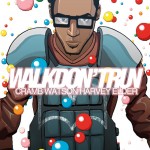 If you look at the titles on the Madefire app, alongside big names like Injustice: Gods Among Us or Hellboy in Hell and Madefire originals like Mono or Captain Stone Is Missing, is a title called ‘Walk Don’t Run’ that you might just have missed. It’s not got a big name publisher or a big name creator behind it, but it’s one of the most exciting motion books around. The brain child of Scottish writers Fin Cramb and Sean Watson, it’s set in a teenage high school where the students are literally fighting for survival at every moment. It’s like the Breakfast Club meets Battle Royale, but at no point is what is actually happened explained to you. Keen to get to the bottom of exactly what we were reading we caught up with Fin and Sean after the release of the second instalment of WDR to find out more about this undiscovered motion book marvel!
If you look at the titles on the Madefire app, alongside big names like Injustice: Gods Among Us or Hellboy in Hell and Madefire originals like Mono or Captain Stone Is Missing, is a title called ‘Walk Don’t Run’ that you might just have missed. It’s not got a big name publisher or a big name creator behind it, but it’s one of the most exciting motion books around. The brain child of Scottish writers Fin Cramb and Sean Watson, it’s set in a teenage high school where the students are literally fighting for survival at every moment. It’s like the Breakfast Club meets Battle Royale, but at no point is what is actually happened explained to you. Keen to get to the bottom of exactly what we were reading we caught up with Fin and Sean after the release of the second instalment of WDR to find out more about this undiscovered motion book marvel!
Tell us a bit about the basic premise for Walk Don’t Run? How did you and Sean come up with the idea of a load of high school kids running for their life and how did it develop over time?
SW: Walk Don’t Run is a coming of age story at it’s core; it’s about a group of kids that live in a really dangerous and violent world and are desperately trying to survive. A lot of the major themes kinda came from the first conversations we had but the actual story came a wee while later. We knew we wanted to talk about growing up and things that come along with it, but a literal depiction of high school felt a bit dry and as we talked it through the story it became more exaggerated and fantastical and the world started to come together.
FC: For me it came from talking a lot about how slick a lot of teenage stories are, especially on TV. Things like Skins for example seemed so alien to my memories of being a teen that . I think one of the great things about collaborating is the way those conversations grow and suddenly your own memories and interests have become the beginning of a story.
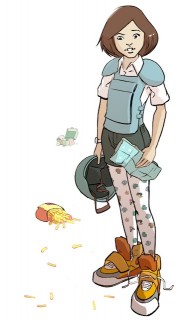
You seem to deliberately keep the overall premise of the series shrouded in mystery throughout the first two issues is that intentional to retain the mystery of what’s going on or are you just trying to avoid too much exposition in your writing?
FC: That’s definitely all part of the fun! One of the things we talked about a lot was the strange mix of the mundane and fantastic when you’re a teen – unfamiliar feelings and new experiences, things you can’t really understand or articulate precisely and just have to live through.
SW: The ambiguity was definitely the plan from the start, we wanted to try and capture that feeling of being a teenager, where you feel constantly in the dark and still really learning how the world works. Heavy exposition seemed totally at odds with that confusing feeling, so how much we could and should expose from the start came pretty quickly. But the mystery does unravel as the story progresses!
I love the variety of genres on show in the series, it seems to mix the dialogue of a high school teen movie with the kind of action of a ‘teens in peril gameshow’ movie like Battle Royale, as well as having a bit of a Dawn of the Dead zombie invasion feel to it. What were the main inspirations for it from your point of view? And did you set out for it play with genre in that way when you created the characters?
SW: It came pretty organically, in most of the early conversations we talked about a lot of our own teenage years and the things that influenced us at the time and slowly this hybrid thing of Stand by Me and The Breakfast Club mixed with The Warriors and Aliens started to form. It made a lot of sense to me, we wanted to write a story about being a teenager and that’s really the time when you submerge yourself in everything and find out what works for you, so in a way the amount of genres and influences seemed like the most succinct way to illustrate those teenage years within the narrative.
Dawn of the Dead and Battle Royale certainly came into our conversations too. The next episode has a real Lord of the Flies feeling to it and the thing that connects all the examples was this idea of survival, that was really the thread that connected all of the influences and what we were trying to talk about. Be it high school or a zombie apocalypse, you can’t beat it, you can only get through it and come out the other side, hopefully not too scarred and ready for the rest of your life.
FC: Yeah absolutely, one of the interesting things about writing it episodically was how we found genre’s creeping in – and it’s really enjoyable to play into those more and more – different days, different outfits, different experiences – different genres made instinctive sense.
We tried to be pretty open about our own influences, films and books and games that we really enjoy are all in there, I hope a lot of WDR resonates for the readers, recognisable even if surreal.
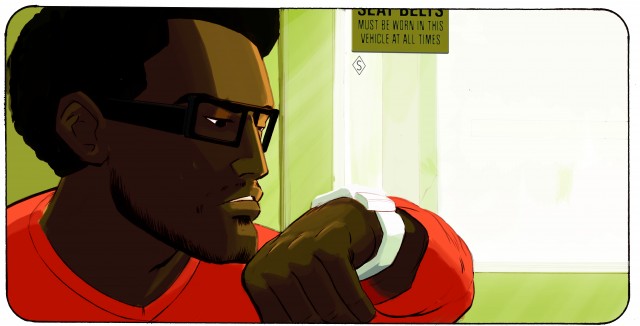
It has a very ‘manga’ look and feel to it. How important was that for the type of story you wanted to tell? Does it benefit from being in an ‘Asian’ setting or is it a reflection of you being fans of that genre?
FC: The only thing I was hung up on was that it should be really striking and accessible to the reader – I’m a big fan of loads of different styles of artwork and my tastes change with the weather, so I was never too worried about it fitting into a set track – so long as it looked great! I liked the idea of trying to capture a teenage garage band ethos ourselves – borrow a bit of that teen energy back from our characters and just start making the thing!
SW: The most important thing for me was that the book captured both the youthful energy and cynicism of that age. The two books that have really done that best for me were Rick Veitch’s Bratpack and David Lapham’s Young Liars and I really wanted something that made me feel the same way.
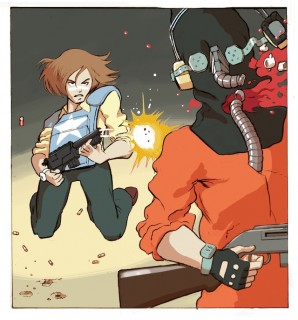
FC: We went looking for folk and James’ illustrations are so punchy and he’s great at gesture and character… it was a real thrill to get him on board and start bringing our characters to life
SW: We looked at a lot of artists online but James really stood out. He did an amazing job at bringing the world to life but it was really his ability to capture emotion and gesture that really caught my attention. The book has a fair share of violent moments but we never wanted it to be gratuitous and really wanted the humanity of the characters to be at the forefront and James did an amazing job at making all of the characters so unique and relatable. He instinctively focused on the characters and not the bloodshed which was exactly what I wanted.
How did you get involved with Liam Sharp’s Madefire crew and what do you think the benefits are of creating Walk Don’t Run as a motion book?
SW: We got the chance to talk to Liam when Madefire was still coming together, we were sent a few videos and you could tell that the guys were really passionate about this really being a new form of storytelling and their enthusiasm was infectious. The tool is a fantastic way to really establish the tone we were going for; the music, sound effects and animation can really bring you into the world but it’s obviously always important to use them to compliment James’ art without it becoming a distraction or a gimmick.
FC: Aye I feel the same way about it, there’s obviously a temptation to use every flashy effect under the sun, but the real fun comes in figuring out where it’s working already and where it could be pushed. I think that’s been a hidden bonus of working digitally for me – it’s really got me looking at the potential of the page, it’s a great discipline to be thinking about what you’re doing and why and the conversations we find ourselves in about the Madefire pages really encourage that
Do you have to work in a different way to accommodate the motion elements of the story telling and how important are they for you or do you prioritise story over flashy transitions?
SW: There’s always a temptation to add more and more but sometimes even a really small transition, a light switching on or something, can add more to the moment than some elaborate motion element.
FC: It’s been eye opening adapting WDR into a motion book – we originally made it as a normal flat page comic so it’s been interesting looking at ways to re-treat the panels and add to the experience without interfering with the things that are already great. We made a decision early on that it would still resolve as pages-and-panels but try to add to the experience of moving through those moments.
We’ve recently had the opportunity scripting specifically for motion comics for Madefire from the ground up, which is great fun and has opened the floodgates for us trying to figure out what could be done, the second you catch yourself going “could we actually do that?” – you know you have to try!
Really at the bottom line It’s all about story for me regardless of platform – if you can keep the reader invested and enjoying the experience then that’s the game and I’m enjoying the different tools that digital comics allow you to do that with.
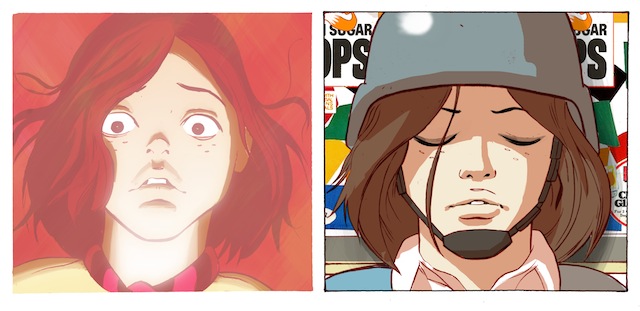
Are you big fans of digital comics as a medium, which titles to do you think are pushing the boundaries and how important do you think digital comics are to the world of comics as a whole?
FC: Yeah I am a really big fan, more so than I expected in a way – not that it precludes me loving physical books you understand, I just think of the things as different experiences now. There will always be stuff I’m proud to have physically on my shelves at home but I definitely want to see where else we can go as well. I mean, in a way I think the gulf between digital and physical comics is as big or as small as you make it – it’s an exciting time to be making comics!
I think comics have always been great for diversity and plowing into the unknown – with digital comics offering up such a fantastic expanse of undiscovered country I can’t imagine a richer status quo for an artform.
Obviously I’m totally biased from working on it, but MONO was really eye opening for me, especially seeing the first pages and realising the scope of how they were going to work. Warren Ellis’ Freakangels opened a door for me into webcomics in a way that made me wonder why it took me so long! I hugely enjoyed Cameron Stewart’s Sin Titulo and The Wormworld Saga by Daniel Lieske both for how much they blew me away in their (very different) approaches. More recently I was reading NIKO And the Sword of Light which is stunning and it’s take on what a digital comic could be is really well executed. I think as well the new Batman: Arkham Origins stuff from Madefire is cool, the reader actually influencing the story offers up some interesting arty thoughts on where you can go with it
SW: For me, Liam’s Captain Stone is Missing is the book that excites me the most. A few years I wouldn’t have associated subtly and nuance with motion comics, they seemed to be mostly explosions and small pieces of character animation, you know they kinda sat in weird place that was neither a cartoon or a comic. But Captain Stone was really something that I hadn’t ever seen before and at the same time established a grammar for how Motion Books could be made. It’s amazing to see an artist as talented as Liam have all these other tools at his disposal to tell the story, it’s just a really graceful and beautiful book.
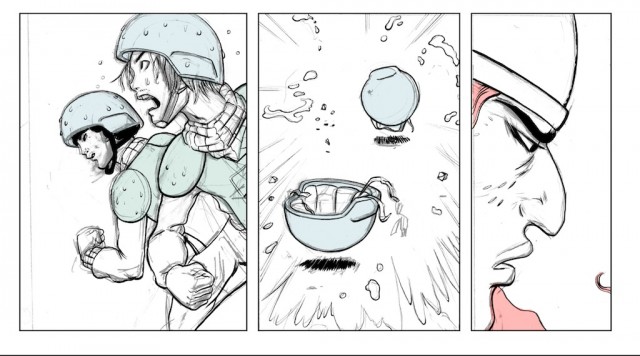
SW: Along with working on WDR I’ve been enjoying working as an animator on Star Trek and Injustice for Madefire, also recently we’ve written a story for Dave Gibbon’s TREATMENT series called TREATMENT: Edinburgh with Dan Brereton as the artist. It’s nerve-racking to be involved with such talented people again but it’s hugely exciting and it’s set in our hometown which we get to blow up, so that’s been a good laugh!
FC: TREATMENT: Edinburgh is a blast to be doing – Dan Brereton’s artwork is in a league of it’s own and it’s cool to get to bring a bit of ourselves into the growing TREATMENT canon!
I’m loving working on the colours for MONO for Ben Wolstenholme and Liam Sharp also, which is such eloquent and moody stuff it suits me right down to the ground
There’s also a few projects closer to home too, enjoying working with Jim Alexander and Will Pickering on the upcoming Savant – and working on The Broons for DC Thompson has been a recent personal high point.
As for WDR we had originally imagined it as a physical book and that’s still something we’d all love to see happen alongside the motion book – Sean and myself have a couple of things up the sleeve too which will be great when we can let the cat out of the bag
Walk Don’t Run #1 and #2 are available from the Madefire app for iPhone and iPad as a free preview and £0.69/$0.99 for the full issue.



December 20, 2025 @ 5:32 pm
In der bet365 App steht Ihnen dann das selbe Angebot
zur Verfügung wie auf der Variante über den Browser.
Für die App lautet der Code genauso wie der “normale” bet365 Promo
Code. Anschließend gilt es nur noch den bet365 App Angebotscode einzugeben. Einfach über den PlayStore
die bet365 App Android herunterladen und installieren,
alternativ können Sie für iPhones natürlich den App Store nutzen, um die bet365
App zu installieren. Selbstverständlich gibt es nicht nur eine Browser Version von bet365 sondern auch einen bet365
App Download, den man über verschiedene Wege durchführen kann.
Sie können mehrere Wetten kombinieren und so durch
den bet365 Bet Builder eine höhere Gesamtquote
erreichen.
Durch geringe Mindesteinzahlungsbeträge müssen Sie keine hohen Summen einzahlen, um den Buchmacher mit unserem bet365 Angebotscode zu testen. Anschließend erhalten Sie der Höhe
Ihrer ersten Wette entsprechend bet365 Wettcredits als Gutschrift auf Ihrem Konto.
Der Willkommensbonus für neue Kunden wird in Form
von bet365 Wettcredits gewährt. Unser Bonus Code Experten Team überprüft den Code
jeden Tag auf die Verwendbarkeit, so können Sie sicher sein einen bet365 Angebotscode der funktioniert zu
erhalten. Bereits mit geringen Mindesteinzahlungsbeträgen lässt sich
der bet365 Bonus aktivieren und ist dadurch für Einsteiger und Profis gleichermaßen geeignet.
References:
https://online-spielhallen.de/888-casino-promo-code-ihr-weg-zu-exklusiven-boni-und-vorteilen/
December 26, 2025 @ 5:18 pm
A fast and secure casino login Australia is what players need to
get instant access to King Billy Casino’s games.
All security features including session management, device
recognition, and threat monitoring work seamlessly on mobile devices, ensuring that your account
remains protected regardless of how you choose to access it.
King Billy casino is a one of the best online casino in Australia, offering a wide range of games and pokies,
generous bonuses, and a user-friendly platform for players.
Critically, all mobile login features are fully synchronized with your desktop access, ensuring a consistent and uninterrupted
cross-platform gaming journey.
King Billy Casino provides 24/7 customer support tailored to
Australian players, ensuring fast and professional assistance via live
chat and email. All games, bonuses, and live chat available on mobile.
With over 5,000 titles from top providers, King Billy Casino offers Australian players
an unmatched variety of pokies, live dealer games, and progressive jackpots.
With over 5,000 games, generous bonuses, fast payouts, and full mobile compatibility, King Billy has earned
its crown as a favorite among Aussie gamblers.
King Billy Casino is a top-tier online gaming platform tailored for Australian players.
References:
https://blackcoin.co/what-are-casino-vip-and-loyalty-programs/
December 27, 2025 @ 10:09 am
Our free remote pc access software delivers the same enterprise-grade standards of remote IT
support for personal use. Our free remote pc software
makes connecting to your devices easy. TeamViewer’s global access network
will provide you with the best possible connection, so you can enjoy immersive remote access and
support sessions with fast transfer speeds and high image quality.
TeamViewer ONE unifies remote access, monitoring, and automation so lean teams can prevent tickets, automate tasks, and deliver better
support.
“With TeamViewer, we were able to drastically reduce the time spent per support case. “TeamViewer is an essential tool for our IT support team at Specsavers.
The web app and desktop application both offer the same connection options for supporters,
regardless of license type. Power up offline computers remotely with TeamViewer’s
Wake-on-LAN functionality. Maintain control of critical systems even when no one is physically present to
authorize connections.
TeamViewer fulfills a wide range of remote
support needs while improving productivity and maintaining
connectivity for users across all industries and organizational sizes.
“In order to be able to react quickly, we needed a remote access solution that, in addition to the usual Windows PCs at the workstations, also supported iOS of the latest generation, and in particular our app.”
Whether you’re troubleshooting technical issues or managing business operations remotely, our software provides a
seamless and secure connection. TeamViewer is designed for a variety of use cases, including IT support, remote work, customer service,
and embedded device management. From enterprise operations to IT support, TeamViewer
is your trusted choice for secure, scalable, and intelligent remote access.
The built-in Windows tool requires significant configuration,
poses potential security concerns when exposed to the internet, and doesn’t offer native support for connecting
to macOS, Android, or iOS devices.
References:
https://blackcoin.co/39_best-vip-online-casino-2022_rewrite_1/
December 29, 2025 @ 6:00 am
online poker real money paypal
References:
linktree.biz
December 29, 2025 @ 6:22 am
mobile casino paypal
References:
makeshare.org